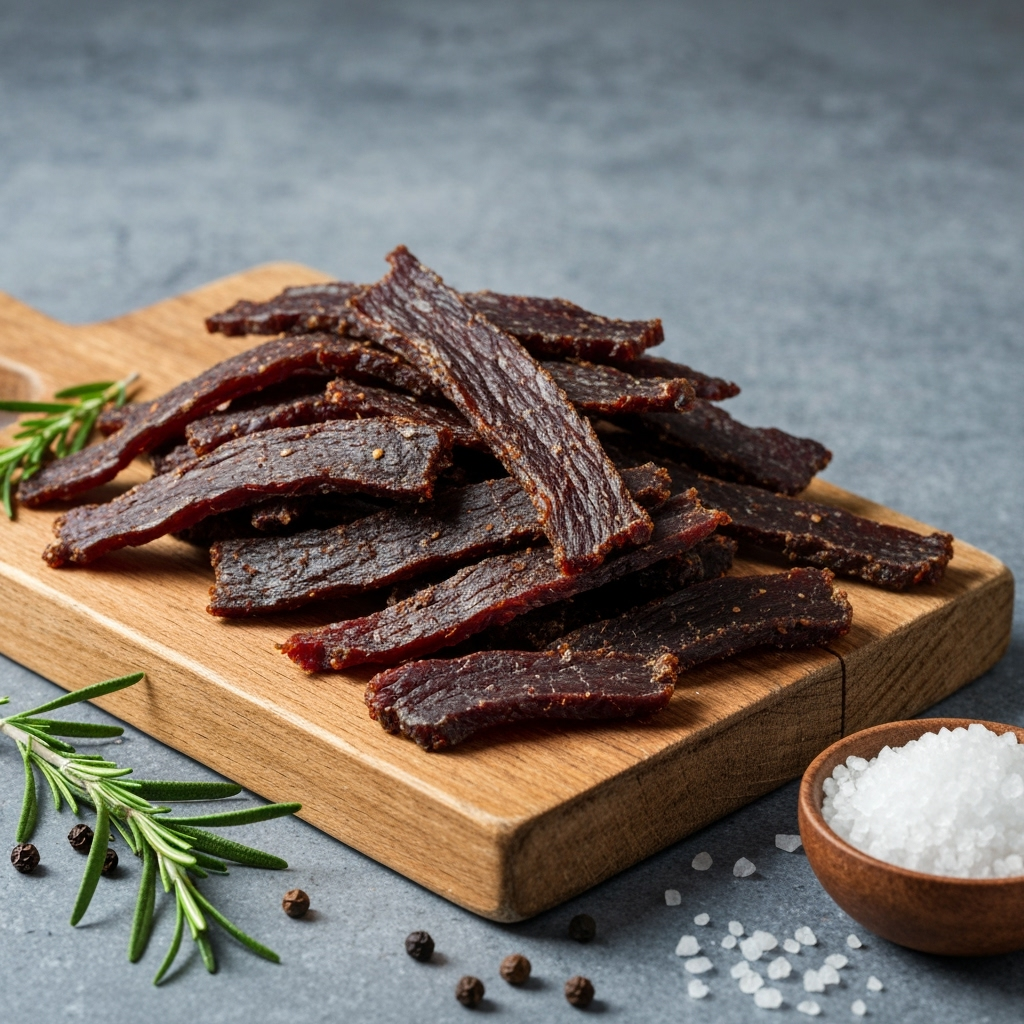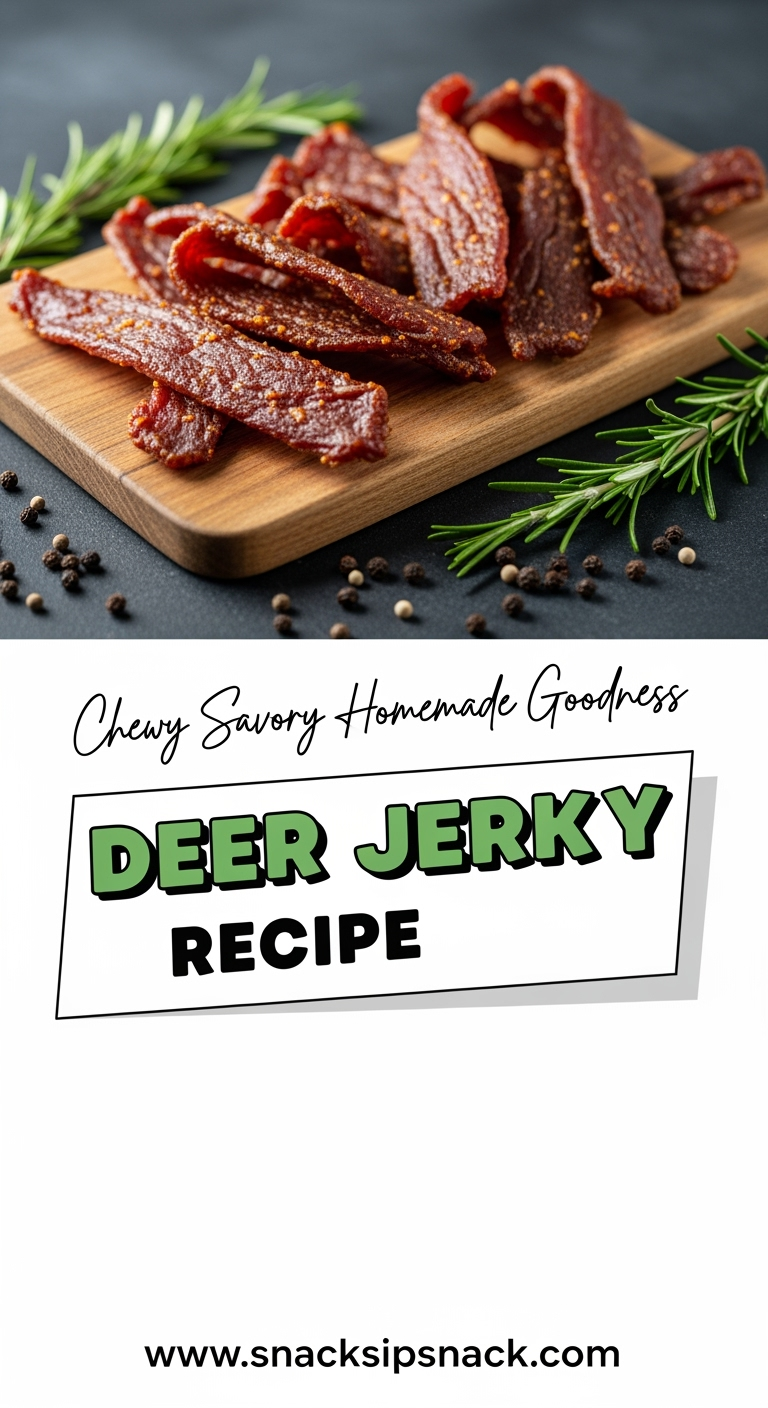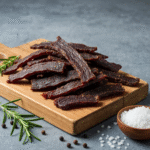There’s something deeply satisfying about making your own deer jerky recipe at home. It’s more than just a snack—it’s a connection to tradition, a way to make the most of a successful hunt, and a project that fills your kitchen with the most incredible savory aroma. I still remember my grandfather showing me how to slice the venison just right, explaining that the secret to great jerky isn’t just in the drying, but in the marinade and the patience required. That first batch we made together was gone in hours, and I’ve been perfecting my approach ever since.
What makes this deer jerky recipe so special is its perfect balance of salty, sweet, and smoky flavors with just the right amount of chew. Unlike store-bought versions that can be tough or overly processed, homemade venison jerky gives you complete control over the ingredients and texture. Whether you’re using an oven, smoker, or dehydrator, this guide will walk you through creating the most addictive savory snack you’ll ever taste.
Table of Contents
Deer Jerky Recipe Ingredients
This deer jerky recipe starts with simple ingredients that create complex flavors. Here’s what you’ll need:
• 2 pounds venison (backstrap, round, or rump roast work best)
• ¾ cup soy sauce (or tamari for gluten-free)
• ¼ cup Worcestershire sauce
• 2 tablespoons liquid smoke
• 2 tablespoons brown sugar
• 1 tablespoon garlic powder
• 1 tablespoon onion powder
• 2 teaspoons black pepper
• 1 teaspoon smoked paprika
• ½ teaspoon cayenne pepper (optional, for heat)
• 1 teaspoon curing salt (Prague Powder #1, optional but recommended for longer storage)
Deer Jerky Timing
• Prep time: 30 minutes (plus 4-12 hours marinating)
• Cook time: 4-6 hours
• Total time: 4.5-18 hours
While this deer jerky recipe does require some planning ahead for marinating, the actual hands-on time is minimal. The extended marinating period is what develops those deep, complex flavors that make this jerky so irresistible.
How to Make Deer Jerky Step-by-Step
Making homemade venison jerky is simpler than you might think. Follow these steps for perfect results every time.
Step 1: Prepare the Meat
Start with partially frozen venison—it’s much easier to slice evenly. Trim away all visible fat and silver skin, as fat can become rancid during storage. Slice against the grain for more tender jerky, or with the grain for a chewier texture. Aim for consistent ¼-inch thick slices for even drying.
Step 2: Create the Marinade
In a large bowl, whisk together soy sauce, Worcestershire sauce, liquid smoke, brown sugar, and all spices. If you’re using curing salt, add it now—this helps prevent bacterial growth and extends shelf life. The marinade should be well-balanced between salty, sweet, and savory notes.
Step 3: Marinate the Venison
Add the venison slices to the marinade, ensuring each piece is fully coated. Cover and refrigerate for at least 4 hours, though overnight (8-12 hours) will yield the most flavorful results. Turn the meat occasionally to ensure even marinating.
Step 4: Dry the Jerky
Remove the meat from the marinade and pat dry with paper towels—this helps the jerky dry rather than steam. Arrange the slices in a single layer on your drying racks, ensuring they don’t touch. The drying method you choose will determine the exact process, but the goal is consistent, low heat that removes moisture without cooking the meat.
Step 5: Test for Doneness
Properly dried jerky should be firm but still pliable. It should bend without breaking and not feel moist or soft in the center. A good test is to tear a piece—you should see fine white fibers but no visible moisture.
Nutritional Information
Per serving (1 ounce):
• Calories: 70
• Protein: 12g
• Fat: 1g
• Carbohydrates: 2g
• Sodium: 480mg
Venison is naturally lean and high in protein, making this deer jerky an excellent high-protein snack. It’s also lower in fat than most beef jerky options, while providing iron, zinc, and B vitamins.
Deer Jerky Recipe Equipment Needed
You have several options for making this deer jerky recipe:
• Oven method: Baking sheets, wire racks, aluminum foil
• Dehydrator: Food dehydrator with multiple trays
• Smoker: Any type of smoker (electric, charcoal, or pellet)
• Sharp knife or meat slicer for even slices
• Large mixing bowls
• Measuring cups and spoons
• Paper towels for patting dry
If you’re new to making jerky, the oven method is the most accessible since most home cooks already have the necessary equipment. For those who make jerky regularly, investing in a dehydrator can be worthwhile for its consistent results and energy efficiency.
Why You’ll Love This Homemade Venison Jerky
• Customizable flavors: Adjust the spices and heat level to your preference
• Healthier than store-bought: No preservatives, MSG, or artificial ingredients
• Cost-effective: Much cheaper than purchasing premium jerky
• Perfect for gifting: Beautifully packaged homemade jerky makes a thoughtful present
• Utilizes wild game: Makes excellent use of venison from hunting season
• Portable protein: Ideal for hiking, road trips, or busy workdays
The satisfaction of creating your own delicious snack from scratch is incredibly rewarding. Once you taste this homemade version, you’ll understand why so many people prefer it to commercial options.
Healthier Alternatives for Deer Jerky

This deer jerky recipe is quite adaptable to various dietary needs:
• Low-sodium: Use reduced-sodium soy sauce and eliminate the curing salt
• Sugar-free: Substitute brown sugar with sugar-free alternatives like monk fruit or erythritol
• gluten-free: Replace soy sauce with tamari or coconut aminos
• Paleo/Whole30: Use coconut aminos instead of soy sauce, and omit the sugar
• Spice variations: Experiment with different pepper blends, add coffee grounds for depth, or include orange zest for brightness
The basic method for how to make deer jerky remains the same regardless of your flavor variations. Don’t be afraid to experiment with different spice combinations once you’ve mastered the basic recipe.
Serving Suggestions for Deer Jerky
While deer jerky is fantastic on its own, here are some creative ways to enjoy it:
• Charcuterie boards: Pair with cheese, crackers, and fruit
• Trail mix: Chop and mix with nuts, dried fruit, and dark chocolate chips
• Salad topping: Crumble over greens for added protein and flavor
• Camping meals: Rehydrate in stews or soups for quick camp dinners
• Bloody Mary garnish: Use as a sophisticated alternative to celery
• Appetizer platters: Serve alongside other smoked meats and pickles
For more high-protein snack ideas that complement jerky perfectly, check out our garlic butter beef bites—they’re another crowd-pleasing option for protein-packed snacking.
Common Mistakes to Avoid with Deer Jerky
• Uneven slicing: Inconsistent thickness leads to some pieces drying out while others remain moist
• Skipping the fat removal: Leaving fat on can cause spoilage and off-flavors
• Over-marinating: Too long in acidic marinade can make the texture mushy
• Rushing the drying process: High heat cooks rather than dries the meat
• Not testing for doneness: Undried jerky can develop mold during storage
• Crowding the racks: Pieces need air circulation to dry properly
Remember that making great jerky is more about technique than complicated ingredients. If you’re looking for more marinade inspiration beyond this deer jerky marinade recipe, our grilled chicken marinade shares some principles that can be adapted for jerky as well.
Storing Deer Jerky Properly

Proper storage is crucial for maintaining quality and safety:
• Room temperature: Store in airtight containers for up to 2 weeks
• Refrigeration: Keeps for 1-2 months in sealed bags or containers
• Freezing: Best for long-term storage (6+ months) in vacuum-sealed bags
• Moisture control: Add a food-safe desiccant packet to containers
• Check regularly: Discard if you notice any mold, off odors, or slimy texture
The key to storing deer jerky is keeping it dry and protected from air. If you plan to make jerky regularly, investing in a vacuum sealer is highly recommended for optimal freshness.
Deer Jerky Recipe Conclusion
This deer jerky recipe delivers that perfect combination of savory, slightly sweet, and smoky flavors that keeps you reaching for just one more piece. The process might seem involved at first glance, but it’s actually quite straightforward once you understand the basic principles of marinating and slow drying. Whether you’re using an oven, dehydrator, or smoker, the result is a protein-packed snack that’s far superior to anything you can buy.
If you enjoy making your own jerky, you might want to explore our other jerky recipes like this classic beef jerky or this unique beefcake jerky variation. Each offers its own distinct flavor profile and texture that jerky enthusiasts will appreciate.
I’d love to hear how your homemade venison jerky turns out! What variations did you try? Did you discover any personal tweaks that made it even better? Share your experiences in the comments below, and don’t forget to tag @Stacksipsnack on Pinterest to show off your jerky-making success. Happy snacking
FAQs about deer jerky recipe
What is the best cut of deer meat for jerky?
The best cuts for deer jerky are lean, solid muscles with minimal fat and sinew. The top round, bottom round, and sirloin tip from the hindquarter are ideal. Flank meat and the eye of round are also excellent choices because they are lean and can be sliced evenly.
How do you slice deer meat for jerky?
Slice the meat when it is partially frozen. This makes it easier to cut thin, uniform strips. Cut u003cstrongu003eacross the grainu003c/strongu003e for a more tender jerky, or u003cstrongu003ewith the grainu003c/strongu003e for a chewier texture. Aim for slices about 1/4 inch thick for the best results.
What is a simple marinade for deer jerky?
A simple and classic marinade consists of soy sauce, Worcestershire sauce, black pepper, garlic powder, and onion powder. For a basic ratio, use 1 cup of soy sauce, 1/4 cup of Worcestershire sauce, and 1 tablespoon each of the spices. Liquid smoke can be added for a smoky flavor.
How long do you dehydrate deer jerky?
Dehydrating time varies by method and thickness. In a food dehydrator at 160°F (71°C), it typically takes 4 to 6 hours. In a low oven (around 170°F or 77°C), it can take 6 to 8 hours. Jerky is done when it is dry and leathery but still pliable.
Do you have to use curing salt for deer jerky?
Using curing salt, such as Prague Powder #1, is not strictly required but is highly recommended for safety. Curing salt contains sodium nitrite, which inhibits the growth of bacteria like botulism, especially important when using lower temperature drying methods.
How long does homemade deer jerky last?
Properly dehydrated and stored deer jerky can last for 1 to 2 months at room temperature in an airtight container. For longer storage, keep it in the refrigerator for up to 6 months or in the freezer for over a year.

Deer Jerky Recipe
- Total Time: 4.5-18 hours
- Yield: 2 pounds 1x
Description
This homemade deer jerky recipe creates the perfect balance of salty, sweet, and smoky flavors with just the right amount of chew. A protein-packed snack that’s healthier and more flavorful than store-bought versions.
Ingredients
- 2 pounds venison (backstrap, round, or rump roast work best)
- ¾ cup soy sauce (or tamari for gluten-free)
- ¼ cup Worcestershire sauce
- 2 tablespoons liquid smoke
- 2 tablespoons brown sugar
- 1 tablespoon garlic powder
- 1 tablespoon onion powder
- 2 teaspoons black pepper
- 1 teaspoon smoked paprika
- ½ teaspoon cayenne pepper (optional, for heat)
- 1 teaspoon curing salt (Prague Powder #1, optional but recommended for longer storage)
Instructions
- Prepare the Meat: Start with partially frozen venison. Trim away all visible fat and silver skin. Slice against the grain for tender jerky or with the grain for chewier texture. Aim for consistent ¼-inch thick slices.
- Create the Marinade: In a large bowl, whisk together soy sauce, Worcestershire sauce, liquid smoke, brown sugar, and all spices. Add curing salt if using.
- Marinate the Venison: Add venison slices to marinade, ensuring each piece is fully coated. Cover and refrigerate for at least 4 hours, though overnight (8-12 hours) yields best results. Turn meat occasionally.
- Dry the Jerky: Remove meat from marinade and pat dry with paper towels. Arrange slices in single layer on drying racks, ensuring they don’t touch.
- Test for Doneness: Properly dried jerky should be firm but pliable. It should bend without breaking and not feel moist in center. Tear test should show fine white fibers but no visible moisture.
Notes
Store in airtight containers at room temperature for up to 2 weeks, refrigerated for 1-2 months, or frozen for 6+ months. For gluten-free version, use tamari instead of soy sauce. For low-sodium version, use reduced-sodium soy sauce and eliminate curing salt.
- Prep Time: 30 minutes
- Cook Time: 4-6 hours
- Category: Snack
- Method: Dehydrating
- Cuisine: American
Nutrition
- Serving Size: 1 ounce
- Calories: 70
- Sugar: 1g
- Sodium: 480mg
- Fat: 1g
- Saturated Fat: 0g
- Unsaturated Fat: 0g
- Trans Fat: 0g
- Carbohydrates: 2g
- Fiber: 0g
- Protein: 12g
- Cholesterol: 30mg
💬 Let’s Stay Connected!
For daily recipes, kitchen tips, and exclusive content, follow me on:
👉 Facebook for behind-the-scenes & community fun
👉 Pinterest for visual inspiration & meal ideas
👉 X (Twitter) for quick tips & trending recipes
📲 Join the flavor journey, your next favorite recipe is just a follow away!










